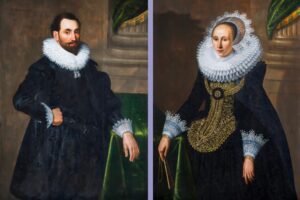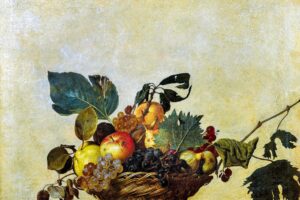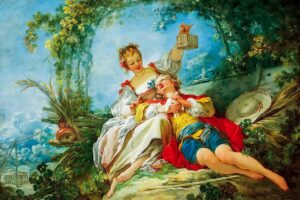Overview
- A Pageant of Childhood* (1899) by Thomas Cooper Gotch is a striking allegory of innocence and imagination. A procession of children in medieval-style garments advances in stately rhythm, bearing instruments, banners, and books. Behind them looms a vast painted figure, suggesting both protection and memory.
Gotch, closely associated with the late Pre-Raphaelite circle and the Newlyn School, infused the painting with symbolic richness. It is both a celebration of childhood’s vitality and a meditation on the rituals of growing up. In its jewel-toned colors, formal arrangement, and dreamlike atmosphere, the work evokes both timeless pageantry and Victorian sentiment.
The Story Behind the Painting
Gotch’s Symbolist Turn
Thomas Cooper Gotch (1854–1931) was an English painter known for portraiture and genre scenes, but by the 1890s he turned toward allegory and symbolism. A Pageant of Childhood belongs to this later phase, where he sought to elevate everyday subjects into poetic ritual.
Inspiration and Meaning
The painting embodies Victorian fascination with childhood as both idealized and sacred. The children are not shown in play but in procession, as if enacting a ceremony of life itself. The title elevates their innocence into a universal pageant — childhood as a stage that every person passes through, fleeting yet formative.
Reception
When exhibited in 1899, the painting was admired for its originality and decorative splendor. It reflected the era’s broader interest in symbolism and in viewing childhood as a subject worthy of reverence.
Composition and Subjects
The Procession of Children
At the center, children advance across the canvas in solemn procession. Their robes shimmer in brocaded gold, red, and green, echoing medieval costume. Some hold cymbals and drums, others books and banners. Their expressions are serious, not playful, emphasizing ritual over spontaneity.
Music and Ritual
The inclusion of instruments — trumpet, drum, and cymbals — underscores the idea of a ceremonial march. The blue banner emblazoned with a lion suggests heraldry, linking the children to pageantry and tradition.
The Youngest Figures
To the right, a smaller child in pale blue is gently guided by an older companion, symbolizing guidance, care, and the passage of experience. Another, in a bright red cap, holds a staff, suggesting leadership to come.
The Painted Presence
Behind the children, a colossal painted figure appears faintly on the wall — a bearded man with a contemplative expression. He seems both guardian and memory, perhaps symbolizing wisdom watching over innocence, or adulthood recalling its own lost childhood.
Decorative Setting
The ornate frame and patterned walls heighten the ceremonial quality, transforming the scene into both ritual and artifice. It feels less like a moment observed and more like a timeless allegory staged for reflection.
Art Style and Techniques
Jewel-like Palette
Gotch employs rich, glowing tones — crimson, gold, and emerald — that evoke both Pre-Raphaelite color and the opulence of medieval pageantry. The contrast of solemn expressions with decorative brightness creates a haunting balance.
Symbolist Influence
Unlike earlier Pre-Raphaelites, who emphasized narrative clarity, Gotch leans into Symbolism. The children become archetypes rather than individuals, embodying innocence, transition, and ritual.
Fusion of Realism and Allegory
The figures are painted with naturalistic precision, yet the staging, costumes, and monumental background presence transport the work into allegory. This duality defines Gotch’s late style.
Legacy and Reflection
A Defining Gotch Masterpiece
A Pageant of Childhood is among Gotch’s best-known works, representing his shift toward allegorical grandeur. It bridged the Pre-Raphaelite devotion to beauty and detail with the fin-de-siècle fascination for symbolism and ritual.
Enduring Meaning
The painting continues to resonate as a meditation on childhood’s fleeting nature. In the solemn march of children, Gotch reminds us that innocence itself is both celebration and farewell — a pageant that passes too quickly, yet lives forever in memory and art.
Children march across the canvas, clad in gold and crimson, bearing books and banners, their music solemn. Behind them, wisdom gazes on. In A Pageant of Childhood, Thomas Cooper Gotch captures the fleeting wonder of youth, elevating innocence into ritual, and memory into pageant.



